Stele of the 3 provisory cemeteries
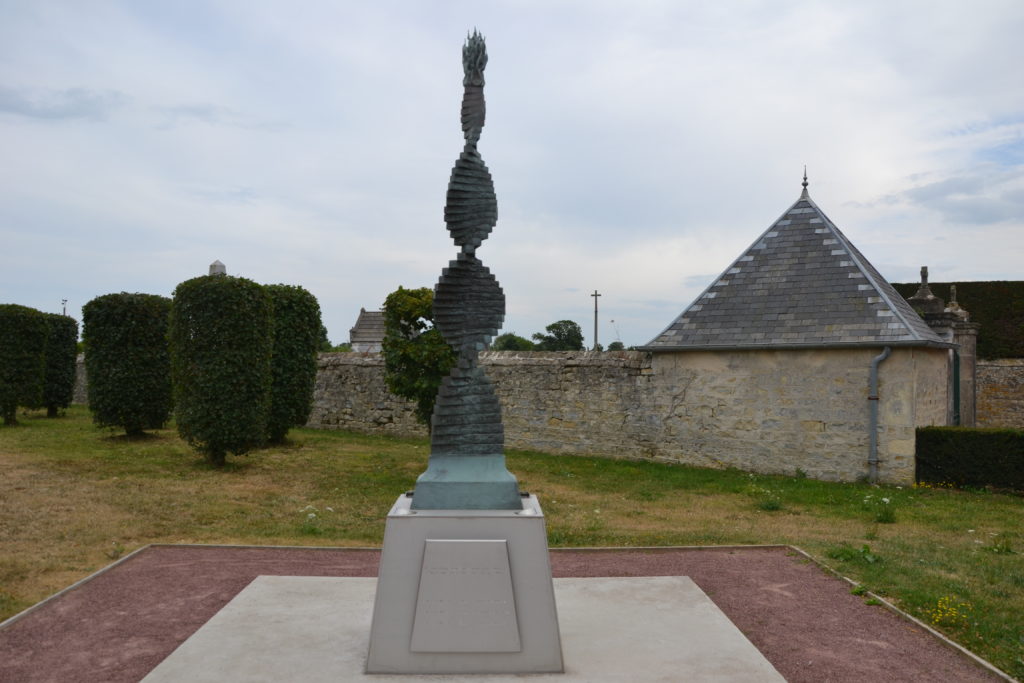
This stele has been erected in homage to the 3 provisory cemeteries having been established between 1944 and 1948 following the fights in the Sainte-Mère-Eglise area, which had caused 13787 american casualties. The first was located near the town’s stadium; the second was near what is now the supermarket; the third was in Blosville-Carquebut, a small village nearby. The American families weren’t allowed to demand repatriation of their deceased loved ones until localization, counting and identification of all the soldiers hadn’t been effectively achieved. They finally got the permission to obtain it in 1947. Estimations indicate that approximately 60% of the families asked for the corpses back, while the remaining 40% decided that they should rest where they fought and perished. These soldiers were then transferred to the newly built American cemetery of Colleville-sur-Mer, or in Saint-James. The stele has been inaugurated on June 7th 2019, in attendance of George Ciampa, one of the 125 american soldiers tasked to bury their fallen comrades after the fights. It was created by artist Yannec Tomada.
Stele Alexandre Renaud
Alexandre Renaud was the mayor of Sainte-Mère-Eglise when the Allies landed in Normandy. He had become mayor at the beginning of 1944, following the untimely death of the previous one, Mr. Leroux. A World War I veteran himself, during which he had earned the Croix de Guerre, he had then reconverted into a pharmacist. Mr. Renaud became a symbol of the French-american friendship following D-Day and the end of the war, by developing and nurturing a strong link between Sainte-Mère-Eglise and the US, that was based on hospitality of the soldiers and their families, and the commemorations of the fights. The stele in his honour was inaugurated on April 28th 1968, 2 years after his passing. It was created by sculptor Paul Deschamps, and is located on the main square of the town, along the General de Gaulle Street.

Airborne Monument
A plate dedicated to Clifford A. Maugham, american paratrooper from the 505th PIR of the 82nd Airborne, who landed in the garden of the house where the plate is, at 1:45am in the night of June 6th 1944. There are also the names of the whole 2nd section of the F Company.
Bienaimé Agnès de Beuzeville Monument:
Place named in honor of Poilu Bienaimé Agnès, the only man from Beuzeville-sur-Plain who died during the WWI. Mr. Agnès didn’t live in the village when the war broke out, but still was one of its sons. Beuzeville is notoriously known as the only French town to not have suffered any war-related casualty in the last 150 years at least – aside from Mr. Agnès of course – which explains the absence of war memorial. During WWI, the 14 inhabitants who had enrolled all came back ; following the WWII, there have only been 2 war prisoners ; and even when travelling back even further in the past, it seems that Beuzeville has always been very fortunate as its community remained intact from the various conflicts. However, death has indeed struck in the town during D-Day: on June 6th, at 11:12am, a C47 plane from the 439th Troop Carrier Group, transporting 17 paratroopers from the 506th Infantry Regiment with its 5 crew members, was fatally struck by Wehrmacht DCA, and crashed in the town. All were on the spot. This is why a stele to their memory was erected on June 6th 2000.
Gavin and Ridgway Stele
This stele pays homage to generals James M. Gavin, brigadier-general from the 82nd Airborne, and Matthew Ridgway, commander of the same division during D-Day, who were key characters of the liberation of Sainte-Mère-Eglise and the area nearby.
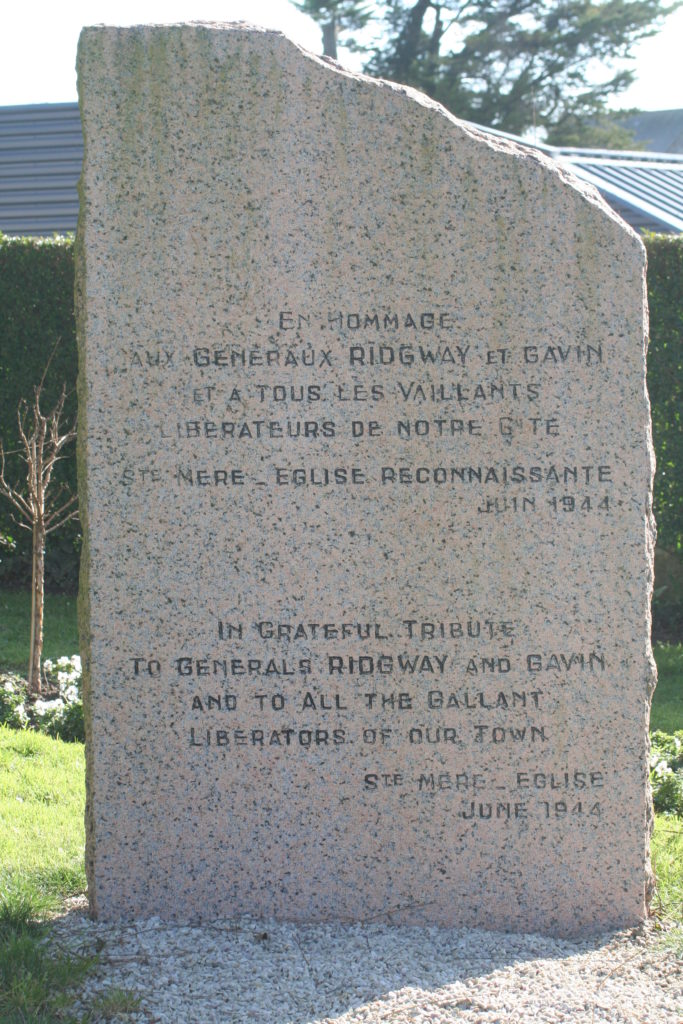
Milestone Zero
The Liberty Road extends from Sainte-Mère-Eglise to Bastogne. It commemorates the Allies’ victory and the Liberation of France, Belgium and Luxembourg following the events of June 6th 1944. It consists of kilometric milestones punctuating the road network between Sainte-Mère-Eglise (borne 0) and Utah Beach (borne 00) on one hand, and Bastogne in Beligum on the other. IT follows the itinerary of General Patton’s IIIrd Army, from its landing in Normandy and its breakthrough in the Cotentin, to its now famous trail that led it to Metz in only 54 days. Thus, a borne can be found at each kilometre of the army’s trail. This project was initiated simultaneously from the war’s ending, by colonel Guy de La Vasselais, former chief of the French military mission assigned to tactical liaison in the XXth corps of the IIIrd Army. La Vasselais wanted to create a large scale monument in remembrance of the progression of the Allied armies. The final borne, the Bastogne one, was placed on July 5th 1947, whereas the borne 0 of Sainte-Mère-Eglise was placed on September 16th 1947, in front of the city hall. The model of the borne was sculpted by François Cogné, and was originally made of pink cement, 1 meter tall. However, in France, numerous milestones had to be replaced by lighter copies, thus less dangerous in case of traffic accident. The borne depicts a flame symbolically heavy: it is the symbol of liberty, of which the torch is held above waters, recalling the troops’ arrival by sea; this torch is also reminiscent of New-York’s statue of liberty.
Prisoners’ camp monument
The monument of the liberation of Foucarville was created to commemorate the prisoners’ camp that was located on departemental road 14 between Ravenoville and Foucarville. Following D-Day, the US Army quickly had to build a camp in order to house all the German prisoners. It was named Continental Central Enclosure n°9 and was 100 hectares large. Lieutenant-colonel Kennedy was its commander. It was elaborated by the American engineering who put tasked the prisoners themselves to build it. A bakery, a school, a cinema, two theatres, a hospital or even two churches could be found inside. It reached 40 000 simultaneous prisoners, including 200 generals and 4 admirals. All in all, more than 100 000 men transited in it. It was closed at the beginning of 1947.
Iron Mike monument
The Iron Mike monument of the bridge of La Fière commemorates the violent fight that took place between the 6th and 9th June 1944, opposing the american paratroopers to the german soldiers, for the control of the bridge, which crossed the Merderet river, west of Sainte-Mère-Eglise. This fight, which quickly turned to trench warfare, caused heavy casualties on both sides.

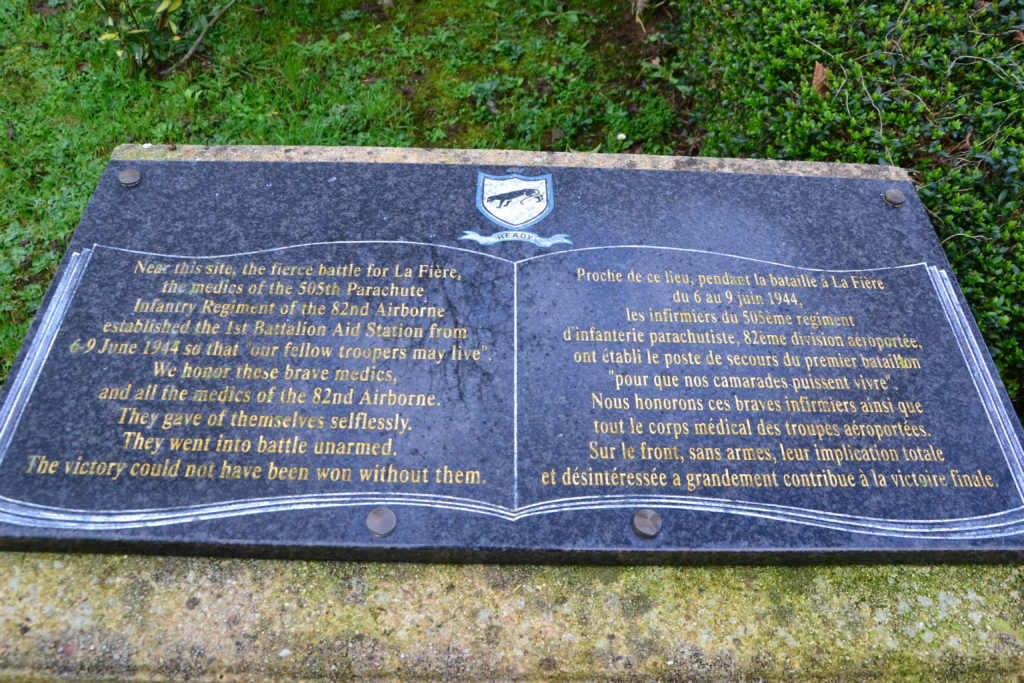


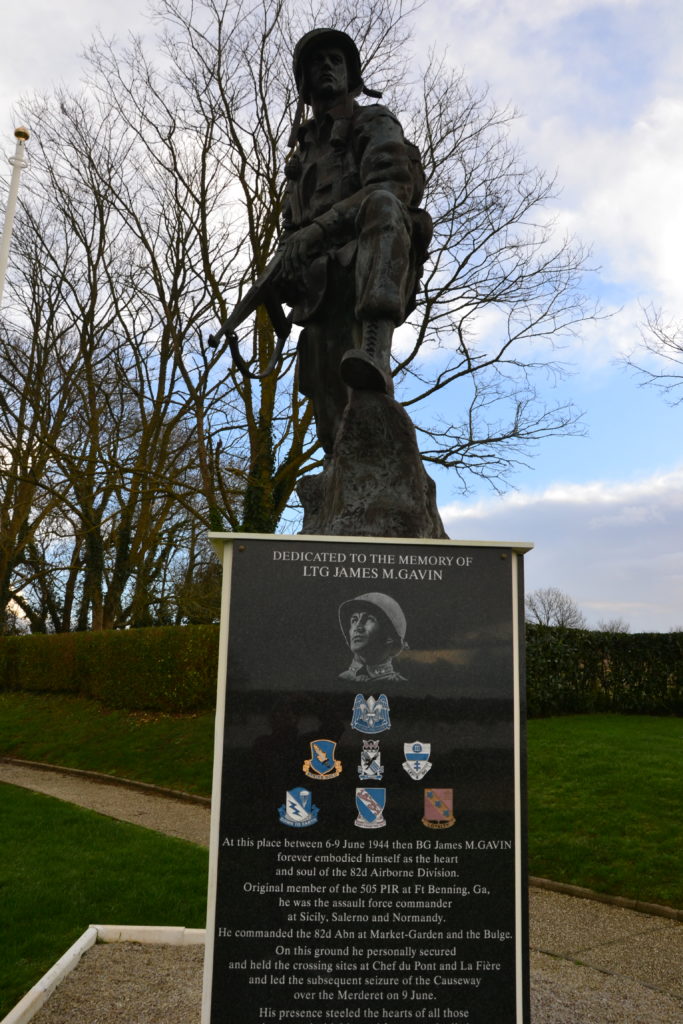
Teddy Roosevelt Jr. statue
The last monument to date, to have been erected in Sainte-Mère-Eglise. It has been inaugurated on June 6th 2022. This bronze statue is heavy with symbolism. Made in Boston, USA, it was offered to the city by the Operation Democracy foundation, in collaboration with American Legion. Its base was made from Lessay stone by the Renov des Marais company of Sainte-Mère-Eglise, under the supervision of the mayor. According to Cathy Cyphers Soref, representative for Operation Democracy, it serves as a reciprocal for the Statue of Liberty, which was a gift from France to the USA. This project dates back to 2018, when Sainte-Mère-Eglise’s mayor at the time, Jean Quétier, and Susan Eisenhower, the general’s granddaughter, initiated the discussion with the foundation. Theodore Roosevelt Jr., who was already a WWI hero, got back in the army in April 1941, despite his health issues, as commander of the 26th Infantry Regiment of the 1st Infantry Division, the same one whom with he had fought during the Great War. Several months later, he was promoted brigadier-general. After the North Africa campaign, Roosevelt landed on Utah Beach with his men on June 6th, at the age of 56, making him the only general to have participated to the first assaults with his men on that beach. Later, on July 12th, he died from a heart attack in Méautis. This statue is a homage to his impetuous character, his fraternal and then paternal proximity with his men, and his boldness.
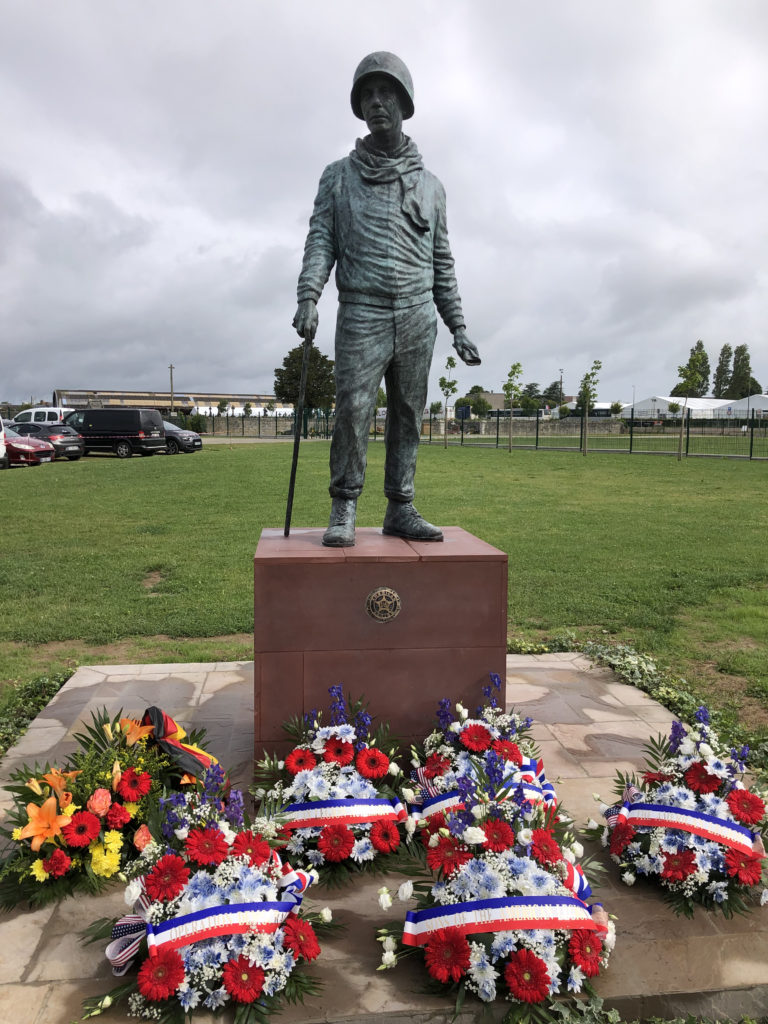
Signal Monument
The Signal monuments are a series of 10 monuments built by the committee of the Normandy Landings, on the historical sites of the Landings. Architect Yves-Marie Froidevaux helmed the realization of this project. There are 3 of them in Manche: in Carentan, in Saint-Martin-de-Varreville, and in Sainte-Mère-Eglise. The latter, which is located in the heart of the town, commemorates the liberation of the canton on June 6th by the 82nd and 101st Airborne Divisions.
Garden of the 508th Infantry Regiment of Chef du Pont
On Departemental road 70, at the exit of Chef du Pont, towards Pont-l’Abbé, is a garden where a commemorative monument as well as 3 steles are. The first is dedicated to the 508th Infantry Regiment of the 82nd Airborne.
The first of the 3 steles was built on June 4th 1976 in the middle of the garden.
The second pays homage to O.B. Hill, founder of the veteran associations of the 508th.
The third and last one, installed on June 5th 2012, is dedicated to captain Rex Combs.
Rex Combs monument
Located on the war memorial, in the cemetery near the church, is a stele dedicated to captain Rex Combs, one of the paratroopers of the 508th who liberated Chef-du-Pont on June 6th 1944. That night, a hundred paratroopers from the 507th and 508th of the 82nd Airborne Division, led by lieutenant-colonel Otsberg, assaults the town. Their mission is to take control of the bourg and the bridge of the Merderet. The group approaches the town following the train tracks. The first two attempts at securing the bridge fail. The group then decides to split in two, in order to send a detachment to the bridge of La Fière, another crucial strategic point. There were only 34 soldiers left in the Chef-du-Pont group. Nonetheless, they managed to liberate the town, thanks to a providential weapons and ammunition drop from their comrades in the sky. Captain Combs went on to participate in the fights in Belgium, and Holland. He earned the Silver Star, and the Purple Heart, and was honoured by queen Wilhemine of the Netherlands following his accomplishments in Nimègue, from September 17 to October 4 1944. The stele was inaugurated in 2012. Rex Combs would have turned 100 that year, hadn’t he passed in Chicago in 1976.
Memorial of the Sainte-Mère-Eglise cemetery
Located in the communal cemetery, this monument is dedicated to the fallen soldiers of the wars of the XXth century. It is an obelisk on a bedrock bearing a latin cross and a palm. It is surrounded by pacified shells linked by a chain. The epitaph reads “To the dead for the fatherland 1914-1918”.
- World War I: 55 dead, including Auguste Chapey and Raoul Gallin
- World War II: 1 dead
- Indochina: 1 dead
- North Africa/Algeria: 1 dead
La Londe Airfield stele
Erected in june 1979, this stele commemorates the short existence of the La Londe airfield, the first US Army airfield in France, created by the 552nd AAA AW Battalion led by Colonel Benjamin M. Warfield, from June 12th to July 26th 1944. It is located near the La Londe locality, on the verge of D17, towards Beuzeville-au-Plain.
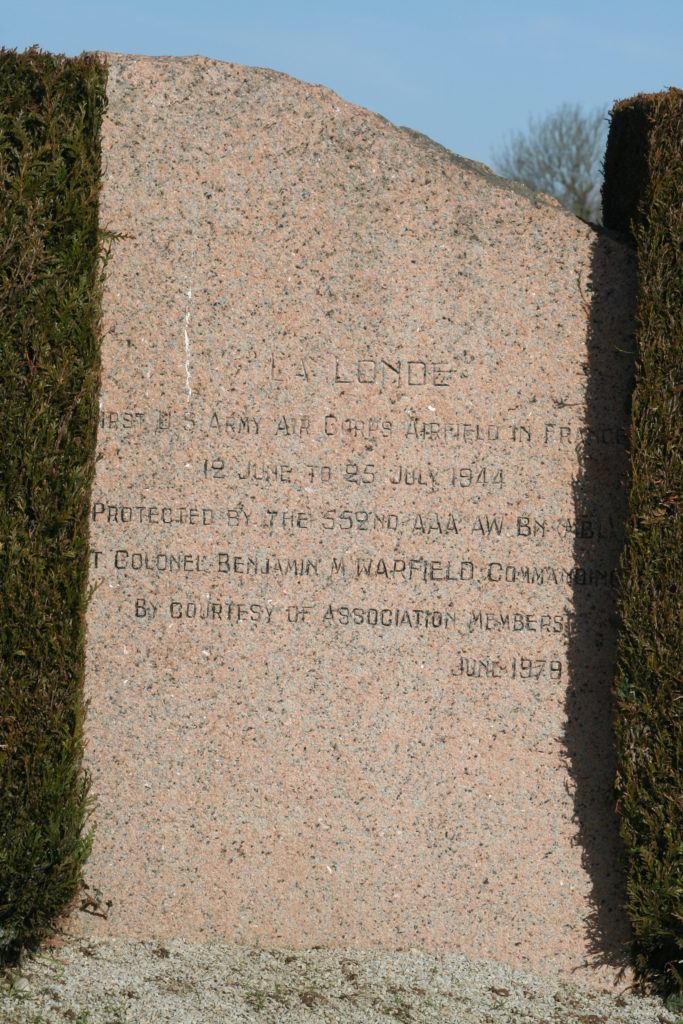
DeGlopper monument
PFC Charles DeGlopper, from the 325 Glider Infantry Regiment (GIR), 82nd Airborne Division, distinguished himself with a great heroic act on June 9 1944. When a part of the 1st Battalion of the C Company got cut off the rest of their group by a german attack, DeGlopper stood up and opened fire on the enemy in order to cover his comrades. Despite his numerous wounds, he kept firing, allowing his comrades to escape and join the rest of their battalion. For this sacrifice, he was posthumously awarded the Medal of Honor, the highest American military distinction, and is the only soldier of his division to receive this award for action during the Normandy campaign.
Father Ignatius Materkowski monument
Father Ignatius Materkowski was a man of God who had volunteered as military chaplain of the 508th PIR, 82nd Airborne Division in 1942. He was parachuted with his comrades during the first hours of the D-Day, in enemy territory, in the Guetteville hamlet, in Picauville. An American glider had crashed nearby and there were many wounded soldiers needing assistance. Father Ignatius began taking care of them, before realizing a suitable aid station was needed. He took a risky decision, and tried to go negociate with his german counterpart, hoping to mutualise their wounded in one common hospital. He crossed the battlefield unarmed, with his chaplain’s insignia and his Red Cross armband, to the Nazi medic. While coming back, he was shot in the back by an enemy sniper, becoming the only American chaplain to meet his maker on D-Day.
Charles Timmes memorial
Lieutenant-colonel Charles Timmes was the commander of the 2nd Battalion of the 507th PIR, 82nd Airborne, who was tasked with securing the western end of the La Fière bridge. But following the parachute jump during the night of the 5 to the 6, the battalion was scattered all along the Merderet river. On June 6’s evening though, Timmes had managed to gather a group of 100 men, in defensive positions in an orchard. From the 6 to the 9, he and his men fiercely repelled multiple german attacks. There are two other commemorative plates on the left and right of the Timmes memorial: the first is dedicated to the 325th GIR, the second to the 508th PIR.
Sainte-Mère-Eglise’s Notre-Dame-de-l’Assomption church
This church, whose foundations date back to the XIIth-XIIIth centuries, is officially listed as a historical monument since 1840. It is a catholic building, of roman style. It rose to worldwide celebrity following the film The Longest Day, which depicted the true story of parachutist John Steele getting stuck on the church steeple.
From that time on, the town’s committee took the initiative to install a mannequin on the church steeple – though not on the same side Steele got stuck, but on the other, for the people on the church place to see – nicknamed Big Jim, in Steele’s remembrance. The Airborne Museum is in charge of the mannequin’s regular uniform and equipment changes, which are necessary because of the infamous Normandy climate!
The church also bears another memory from the war: its stained glass windows. In 1969, the members of the C47 Club, mostly composed of veterans from the 82nd Airborne, came by train to Sainte-Mère-Eglise for the commemorations of the 25th anniversary of the D-Day. There, they promised to finance a stained glass window in memory of their fallen brothers in arms. This promise was quickly kept: on june 4th 1972, the windows were installed in the church following a religious ceremony.
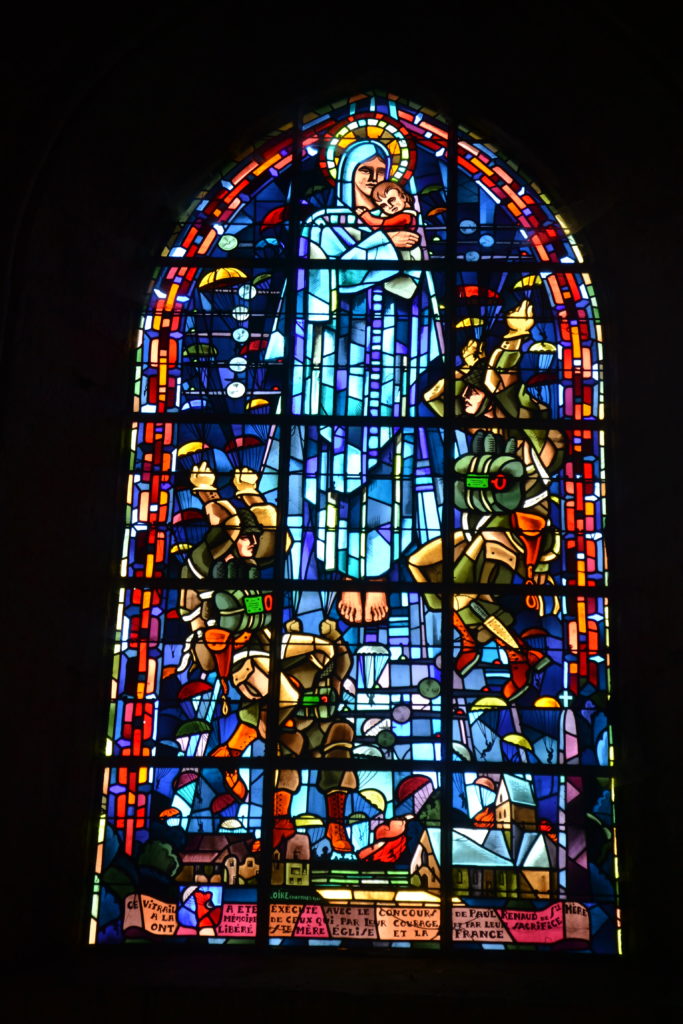


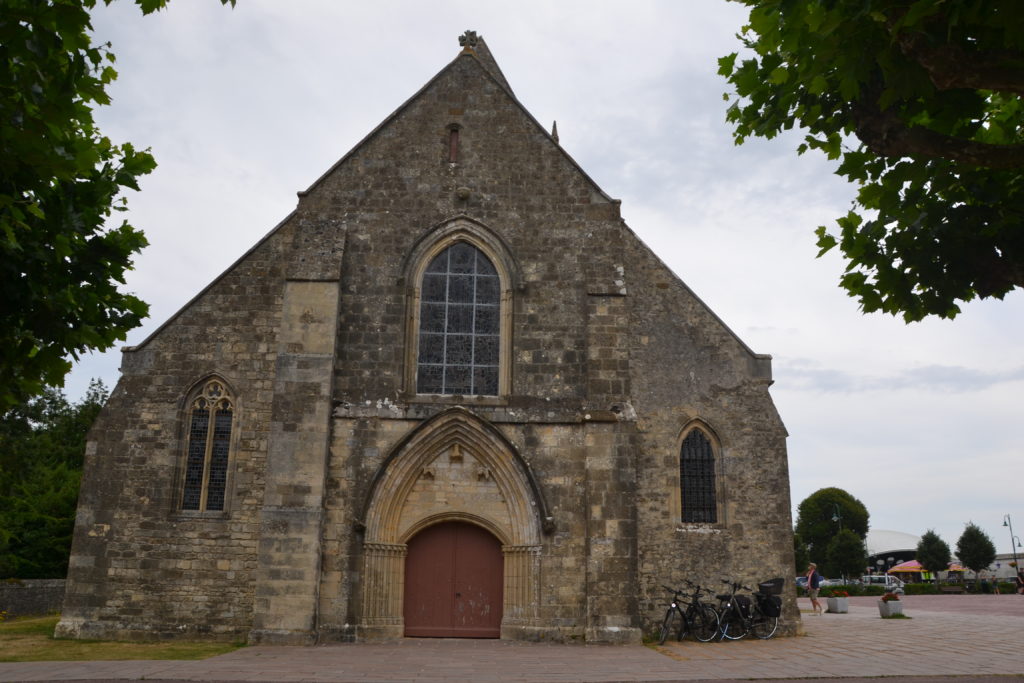

The cross
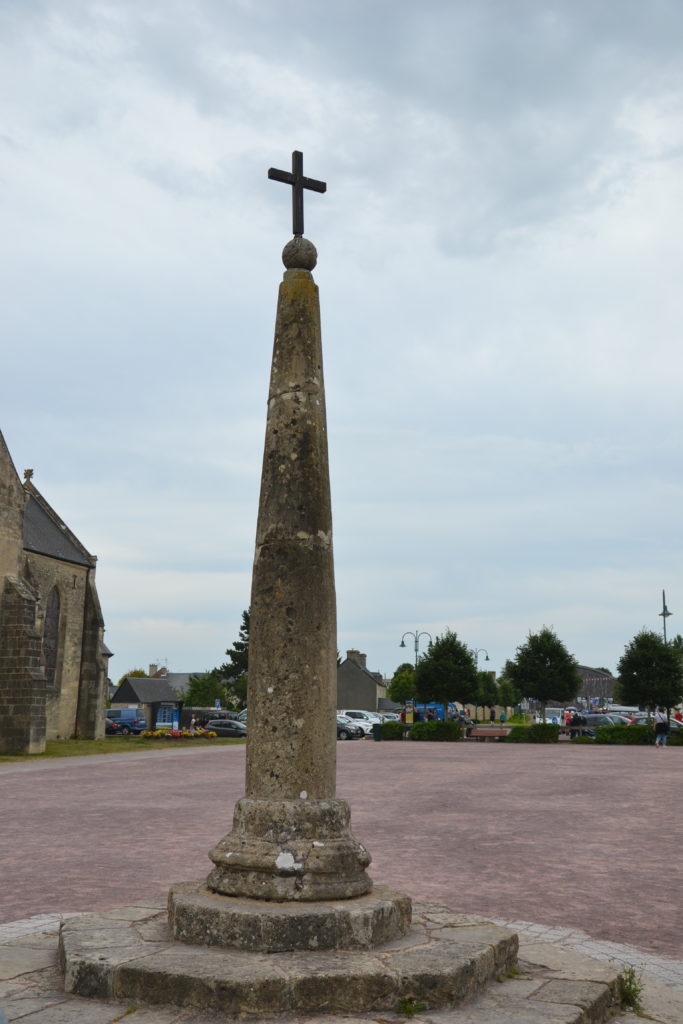
Besides the war related monuments, can be found on Sainte-Mère-Eglise’s church place a “monumental milliaire cross”. It consists of an octagonal pedestal, an attica base, a roman mile borne (the distance unit in ancient Rome was 1000 roman feet, or roughly 1,482km) made of Valognes limestone, a sugar-loaf shaped column shaft, and finally a stone sphere on which was installed a cross. It was first identified by renowned French archaeologist and historian Arcisse de Caumont in 1862.
Besides the war related monuments, can be found on Sainte-Mère-Eglise’s church place a “monumental milliaire cross”. It consists of an octagonal pedestal, an attica base, a roman mile borne (the distance unit in ancient Rome was 1000 roman feet, or roughly 1,482km) made of Valognes limestone, a sugar-loaf shaped column shaft, and finally a stone sphere on which was installed a cross. It was first identified by renowned French archaeologist and historian Arcisse de Caumont in 1862.
Nonetheless, this is one of the hypotheses considered by the research circle of Valognes. An enigma that is still yet to be solved!


